Joy Neal Kidney's Blog, page 22
April 6, 2024
School Safety Patrol along White Pole Road, 1950s

I was in 6th Grade in the big brick Dexter school building when we were asked if we’d like to be on safety patrol duty. You bet I did!
The two-story brick schoolhouse anchored the north end of the small town of Dexter, Iowa, but a block south, kids had to cross a busy highway to get to the main part of town. The patrol kids left school a little early at lunch time and after school in order to hike down to the highway and be on duty there when the bell rang for the kids to leave.
White Pole Road, the busy main highway between Des Moines and Omaha.
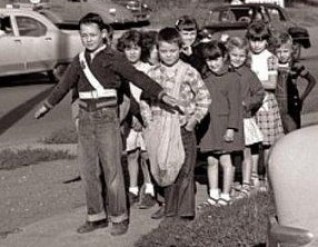 Our duty included wearing white patrol belts and, if a car was coming, holding out our arms to keep back children waiting to cross.
Our duty included wearing white patrol belts and, if a car was coming, holding out our arms to keep back children waiting to cross.
If you ever served as safety patrol, then you well remember the patrol belt. Ours were off-white webbing. The belt section went around the waist, with a shoulder strap that went over the right shoulder. A silver Junior Safety Patrol badge was worn on the shoulder strap.
I remember one patrol kids’ meeting where the superintendent Mr. Wineinger gave instructions. And we were treated to ice cream sandwiches, which I’d never had before.
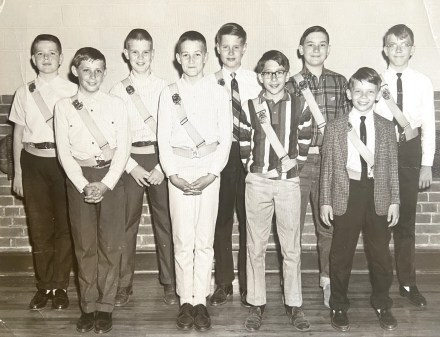 Patrol kids in Tennessee, thanks to Dennis Peterson, who is in the front row wearing glasses
Patrol kids in Tennessee, thanks to Dennis Peterson, who is in the front row wearing glassesThis is how school safety patrol kids began.
April 4, 2024
Dale Wilson’s Favorite Poem: “If” by Rudyard Kipling
 Dale R. Wilson, 1939 Dexter High School graduate
Dale R. Wilson, 1939 Dexter High School graduateDale Wilson grew up in the small town of Dexter, Iowa, during the Great Depression and was a 1939 high school graduate. He enjoyed sports, especially football and basketball, but he had mentioned that this poem was his favorite:
If
by Rudyard Kipling
If you can keep your head when all about you
Are losing theirs and blaming it on you;
If you can trust yourself when all men doubt you,
But make allowance for their doubting too;
If you can wait and not be tired by waiting,
Or, being lied about, don’t deal in lies,
Or, being hated, don’t give way to hating,
And yet don’t look too good, nor talk too wise;
If you can dream—and not make dreams your master;
If you can think—and not make thoughts your aim;
If you can meet with triumph and disaster
And treat those two impostors just the same;
If you can bear to hear the truth you’ve spoken
Twisted by knaves to make a trap for fools,
Or watch the things you gave your life to broken,
And stoop and build ’em up with wornout tools;
If you can make one heap of all your winnings
And risk it on one turn of pitch-and-toss,
And lose, and start again at your beginnings
And never breathe a word about your loss;
If you can force your heart and nerve and sinew
To serve your turn long after they are gone,
And so hold on when there is nothing in you
Except the Will which says to them: “Hold on”;
If you can talk with crowds and keep your virtue,
Or walk with kings—nor lose the common touch;
If neither foes nor loving friends can hurt you;
If all men count with you, but none too much;
If you can fill the unforgiving minute
With sixty seconds’ worth of distance run—
Yours is the Earth and everything that’s in it,
And—which is more—you’ll be a Man, my son!
—–
This poem is in the public domain. That it was Dale’s favorite certainly tells you something about the young man, doesn’t it.
So does this story about what Dale spent bounty money on when he was about the same age.
April 2, 2024
Dennis Simpson has been Barbering for 60 Years!
Dennis Simpson, of Simpson’s Shear Shop, in Dexter, Iowa, has been barbering 60 years, as of April 6, 2024.

That’s since 1964!
Upon graduating with the first class of Dexfield High School in 1960, Dennis received a scholarship to attend barber college and worked for a short time before enlisting in the U.S. Navy in 1961, serving as a barber on the USS Ranger. After his discharge, he learned that one of the two barbers in Dexter had had a heart attack. Dennis applied for a job and, after working there for a dozen year, he purchased the Dexter Barber Shop.
Dennis and Dixie Simpson have three children, six grandchildren, and six great-grandchildren. He’s active in the community, having been a city council member for a dozen years. His daughter, Dana Vry, joined the business and they’ve worked together for 38 years.
He probably gave haircuts to Grandpa Kenneth Neal and my dad, Warren Neal. He gave son Dan his first haircut during the late 1970s at Simpson Shear Shop on Dexter’s Marshall Street.

My favorite Guy still drives to Dexter so Dennis can cut his hair. (They also talk classic cars.) Dana cuts mine.
 Dennis Simpson
Dennis SimpsonStory “Dexter Man Serves Country and Community as Barber for Over 60 Years” by multimedia journalist Roger Riley aired on WHO-TV.
April 1, 2024
An Inheritance of the Most Holy
What an incredible and heart-felt email I received last week!
 “Oh Joy – what a journey I have just taken with Leora, Clabe, the twins, the girls, the boys, the farm, the old John Deere….I can see Leora’s chickens and smell Clabe’s pipe in my dreams.
“Oh Joy – what a journey I have just taken with Leora, Clabe, the twins, the girls, the boys, the farm, the old John Deere….I can see Leora’s chickens and smell Clabe’s pipe in my dreams.
“I wept throughout the stories. And then, I wept when I had finished all the books. I felt like I had closed a chapter on my own life. It was bittersweet. Our stories are our greatest gift. A legacy is an inheritance of the most holy. Thank you for the painstaking research, the documentation and finally for the closure the boys deserved and the family (and I) needed.
“Thank you for sharing the strength of the American spirit, especially demonstrated by the Wilsons and their mammoth heartbreaking sacrifice in the name of our country. I was especially impressed by the utter generosity of all the children to their parents. Whether it be financial or just working to keep the family afloat in good and bad times, the children were obviously raised with generous hearts.
“Carry on, friend. Keep writing. I would love to read more and more about the mid-west and the backbone of the US. Thank you again and again.
“When I retire, soon, I want to visit the graves. I want to see Dexter, Perry, all of Guthrie County the land Leora and Clabe finally owned. I feel like I know all of them and it has been my honor to learn about them and share in your story. What a gift! Thank you.”
Since this came as an email, I asked Heidi’s permission to share it. She said I could. Heidi is from Nashville, so visiting the “Clabe and Leora places” will certainly be a road trip for her!
March 26, 2024
A Legacy of Bibles from my Motherline
 Laura (Jordan) Goff’s Bible, Leora (Goff) Wilson’s, and Doris (Wilson) Neal’s
Laura (Jordan) Goff’s Bible, Leora (Goff) Wilson’s, and Doris (Wilson) Neal’sIn addition to my own Bibles dating from my childhood, I’m the keeper of King James Bibles that belonged to the women in my motherline.
Emelia Ann (Moore) Jordan
My great great grandmother, Emelia Ann Jordan, was married to a lay Baptist minister. She gave a “New Testament of Our Lord and Saviour Jesus Christ” to her oldest daughter, Laura (Jordan) Goff September 30, 1890. Laura was pregnant with her first child, Leora, born that December 4.
Laura (Jordan) Goff’s Self-Pronouncing Bible
Written on a black hard-to-read page inside the one on the left in the photo is “Laura Goff, Key West, Minn.” Looks like she paid $1.35 for it. The Goff family moved to Minnesota with eight children 1903, and moved back to Iowa in 1905 with nine.
Inside are the military ID numbers for Laura’s three sons (Jennings, Merl, and Wayne Goff) who served in WWI, also the two who served in WWII (Rolla and Clarence).
Next is her daughter Leora’s note, “Mother read this Bible twice when she was with Clarence in Omaha.” (That would have been in the late 1930s.)
Under that is Laura’s signature and a notation that she joined the M.E. church at Dexter, Iowa, March 14, 1937, and was baptized there on March 28, 1937 (Easter Sunday) by Rev. J. H. Freedline. This is interesting because she’d moved to Omaha in 1935 and was living with her sons and two motherless grandchildren. She must have been visiting Leora’s family in Dexter when she joined the Methodist church and was baptized there (where she’d attended during the late 1920s and early 1930s while still living in Dexter).
Leora (Goff) Wilson’s Bible
The one in the middle was “presented to Leora F. Wilson, Minburn, Iowa, R.F.D. #1 by Clabe D. Wilson” of the same address, for Christmas 1942, the second Christmas of World War II. “WILSON” is stamped on the front.
Between the Old and New Testaments, Leora recorded family births, marriages and deaths. She also tucked bulletins inside as well as bookmarks and clippings.
There’s no underlining, but it looks like she read it often. Leora also had a smaller Bible, dated September 26, 1952, a Revised Standard Version, which is probably the one she carried to church.
Leora was a member of the First Christian Church in Guthrie Center for decades. She wrote in her memoir, “I also belonged to the Methodist church in Dexter, Iowa, for several years in the 1930s and changed my membership to the First Christian Church in Perry, was baptized in 1946, and transferred to Guthrie Center, Iowa, in 1948.”
Doris (Wilson) Neal’s Bible, Red Letter Edition
Leora’s oldest daughter Doris attended the Presbyterian Church as a child, while the Wilsons lived SE of Dexter. After they moved into town, they attended the nearby Methodist Church with their Grandmother Goff. After Doris married Warren Neal, who was Presbyterian, she joined his church.
Leora’s mother presented Warren and Doris a Bible in 1946, the one on the right in the photo. “NEAL” is stamped on the front. I don’t remember this Bible from my growing up years, but Mom also had a smaller Revised Standard Version which was handier.
*****
I’ve been blessed by several versions of the Holy Bible. My first one was from Grandma Leora, for Christmas 1952, a King James Version. I received a Revised Standard Version (RSV) on Pentecost 1959 (May 17, I was almost 15), presented by the Women’s Association of the First United Presbyterian Church at Dexter on becoming a Communicant Member. These days I’m rereading my English Standard Version (ESV) journaling Bible, which has room for notes.
Each generation must make their own profession of faith. I became a follower of Christ at a junior church camp, and was baptized in 1987 with my husband and 12-year-old son.
How precious it is to have this legacy of faith in my motherline.
—–
All Scripture is breathed out by God and profitable for teaching, for reproof, for correction, and for training in righteousness, that the man of God may be complete, equipped for every good work. – 2 Timothy 3:16-17
March 23, 2024
The Multifoote Paving Contraption
Although I grew up with mostly graveled road, I take paved sidewalks and streets and roads for granted. Until I sifted through my mother’s old photos, I didn’t think about the highway through my hometown of Dexter, Iowa, before it was paved in 1929.
Since it was the first time White Pole Road (also at one time called The Great White Way, and later Highway 6, now numbered 925) was paved, and my mother’s grandfather, Sherd Goff, was part of the process, the story became Chapter 11 in Leora’s Dexter Stories.
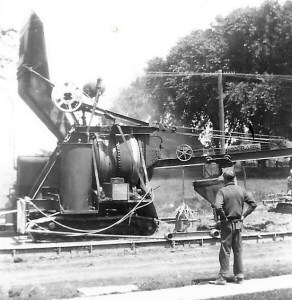 White Pole Road being paved for the first time, 1929, in front of the home of M.S. and Laura Goff, Dexter, Iowa.
White Pole Road being paved for the first time, 1929, in front of the home of M.S. and Laura Goff, Dexter, Iowa.I was certainly struck by an old photo of that paving contraption, a “modern Foote 5A Traction Paving Mixer.”
Two Foote brothers, Chester and Charles, were concrete contractors in NY, with a knack for inventing things. In 1896 they built their own mixer, an improvement over existing designs. In two more years, they had built a workshop and perfected a gas-powered mixer.
In 1903, the brothers founded the Foote Manufacturing Co. and developed the first mixer designed specifically for paving, the No. 3 Continuous Mixer. Their greatest innovation came in 1918 when they perfected the use of crawlers rather than steel wheels. That paver was dubbed the Multifoote and advertised as “The Paving Tank.” I believe one of these contraptions paved at least part of Iowa’s White Pole Road for the first time in 1929.
 Historical Construction Equipment Association photo: The earliest dry batch pavers were simple mixers like this Foote 5A Traction Paving Mixer, working on the Vanderbilt Motor Parkway on Long Island. It receives dry materials at one end of its chassis.
Historical Construction Equipment Association photo: The earliest dry batch pavers were simple mixers like this Foote 5A Traction Paving Mixer, working on the Vanderbilt Motor Parkway on Long Island. It receives dry materials at one end of its chassis.
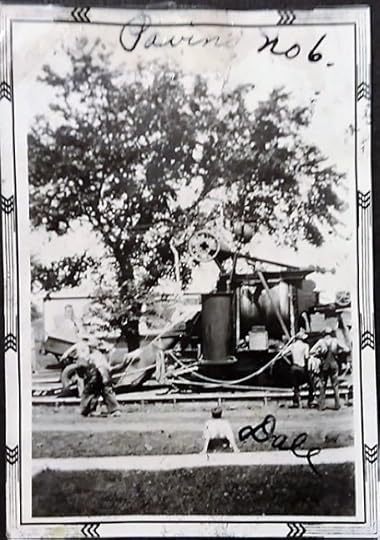
It’s harder to make out the paving machine in the second photo taken in 1929. Mom’s brother, Dale Wilson, is sitting on the sidewalk in front of their grandparents’ home, which still stands in Dexter. Across the road in the old photo was a field with trees and a large billboard. Today, it’s Dexter’s city park.
 The area today. The words in the center say White Pole Road, which was paved the first time in 1929. The old photos are taken from the south side of the street, where Dale Wilson is sitting. The brown roof was Sherd and Laura Goff’s house. (The Wilson family lived in a little house south of there.) Across White Pole Road to the north is the Dexter City Park. There’s a large billboard in a pasture in the old photos.
The area today. The words in the center say White Pole Road, which was paved the first time in 1929. The old photos are taken from the south side of the street, where Dale Wilson is sitting. The brown roof was Sherd and Laura Goff’s house. (The Wilson family lived in a little house south of there.) Across White Pole Road to the north is the Dexter City Park. There’s a large billboard in a pasture in the old photos. The Dexter Park today. The plaque to the right includes the names of war casualties, including Dale, Daniel, and Junior Wilson among the WWII losses.
The Dexter Park today. The plaque to the right includes the names of war casualties, including Dale, Daniel, and Junior Wilson among the WWII losses.
March 21, 2024
Rusty the Pet Squirrel is on the Cover of Leora’s Dexter Stories. What else?
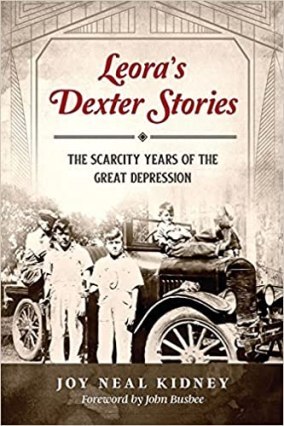 Nelly Murariu @PixBeeDesign designed the cover of Leora’s Dexter Stories, as well as the other Leora books. She also designed the interior and formatted the ebook.
Nelly Murariu @PixBeeDesign designed the cover of Leora’s Dexter Stories, as well as the other Leora books. She also designed the interior and formatted the ebook.
Nelly designed the cover around a photo Leora Wilson took in 1934 to send to her older sons Delbert and Donald Wilson, who had been in the Navy since February of that year. You might remember a photo of them standing next to a Model T Ford truck. Their father Clabe took off the top of the truck that summer.
Clabe is in the driver’s seat in this one, with sons Dale and Danny standing alongside holding their shotguns. Junior is lounging on the hood, focusing on their pet squirrel Rusty.
A closer look at Junior’s shoes reminded me that Clabe owned a set of tools to repair shoes. He bought “whang leather” to make shoestrings for the family.
The stories of the boys joining the Navy, the truck becoming a roadster, and Rusty the pet squirrel are all in the book about the Wilson family as they survived the Great Depression, living “on the dole” and WPA jobs. Clabe sold the roadster that fall. They didn’t have another automobile until 1939!
John Busbee not only edited Leora’s Dexter Stories: The Scarcity Years of the Great Depression, he also wrote the engaging foreword for it.
Robin Grunder shepherded this book (as well as three other “Leora books”) through KDP publication with her own company, Legacy Press Books.
I’m so thankful that Grandma Leora took this winsome photo, and that Nelly created such a delightful cover from it. I wonder what Grandma would say about the old photo she took that day becoming part of the cover of a book about her very own family.
March 19, 2024
Heartwarming Stories, a Review of Leora’s Dexter Stories by Colleen Chesebro
My parents grew up in rural Kansas during the American Depression. I’ve always been interested in understanding what they went through, as my family stories were limited. Once I started reading, I couldn’t put the book down.

The Leora from this book was Kidney’s maternal grandmother, Leora Goff Wilson, who was born in 1890. She died in 1987. Leora chronicled these family stories through her own experiences and through her letters and journals. Kidney’s mother was able to give her own firsthand knowledge of various family events. From this rich family history, Kindey added her own research, including family photographs. This gives the reader a sense of the family.
The stories offer a stark reality of the times. Life in America hinged on the farm economy. During World War I, farmers were urged to buy more land, thinking there would be huge gains. But when the economy failed, most of the farmers lost everything. There were no jobs.
—–
Colleen M. Chesebro grew up in a large city in the Midwest. Keen on making her own way in the world, she joined the United States Air Force after graduation to tour the world and find herself. To this day, that search continues.
An avid reader, Colleen M. Chesebro rekindled her love of writing poetry after years spent working in the accounting industry. These days, she loves crafting syllabic poetry, flash fiction, and creative fiction and nonfiction.
In addition to poetry books, Chesebro’s publishing career includes participation in various anthologies featuring short stories, flash fiction, and poetry. She’s an avid supporter of her writing community on her blog on by organizing and sponsoring a weekly syllabic poetry challenge, called #TankaTuesday, where participants experiment with traditional and current forms of Japanese and American syllabic poetry.
Chesebro lives in the house of her dreams in mid-Michigan, surrounded by the Great Lakes with her husband and two (unicorn) cats, Chloe & Sophie.
Here is Colleen’s Amazon Author Page. I’m grateful to her for this review.
There’s a new audio version of Leora’s Dexter Stories, narrated with “virtual voice.”
March 18, 2024
A Wisconsin State Microbe and an Iowa State Fossil? What will they think of next?

Each of the the 50 states of the union have an official seal, official flag, and an official bird, tree, flower, and song. Some (like Iowa) have an official rock.
Recently artist Renee Graef posted encouragement for an official microbe for her state of Wisconsin, along with her delightful illustration: “I’m for Lactococcus Lactis to be Wisconsin’s official State Microbe!
“It is integral in the making of cheese and buttermilk. Passing AB 800 is a wonderful opportunity for students to learn about the cheesemaking process and microbiology.
“We like good microbes!”
Only a few states have an official state microbe.
Several have state fossils, including Wisconsin. Iowa has neither.
I know the Iowa State Legislature has more important things to do, but I’d like to see the crinoid as Iowa’s State Fossil. So would The Culture Buzz‘s John Busbee, who has collected crinoids for decades. Here’s his column from an earlier issue of Iowa History Journal.
A Wisconsin State Microbe and an Iowa State Fossil?

Each of the the 50 states of the union have an official seal, official flag, and an official bird, tree, flower, and song. Some (like Iowa) have an official rock.
Recently artist Renee Graef posted encouragement for an official microbe for her state of Wisconsin: “I’m for Lactococcus Lactis to be Wisconsin’s official State Microbe!
“It is integral in the making of cheese and buttermilk. Passing AB 800 is a wonderful opportunity for students to learn about the cheesemaking process and microbiology.
“We like good microbes!”
Only a few states have an official state microbe.
Several have state fossils, including Wisconsin. Iowa has neither.
I know the Iowa State Legislature has more important things to do, but I’d like to see the crinoid as Iowa’s State Fossil. So would The Culture Buzz‘s John Busbee, who has collected crinoids for decades. Here’s his column from an earlier issue of Iowa History Journal.



